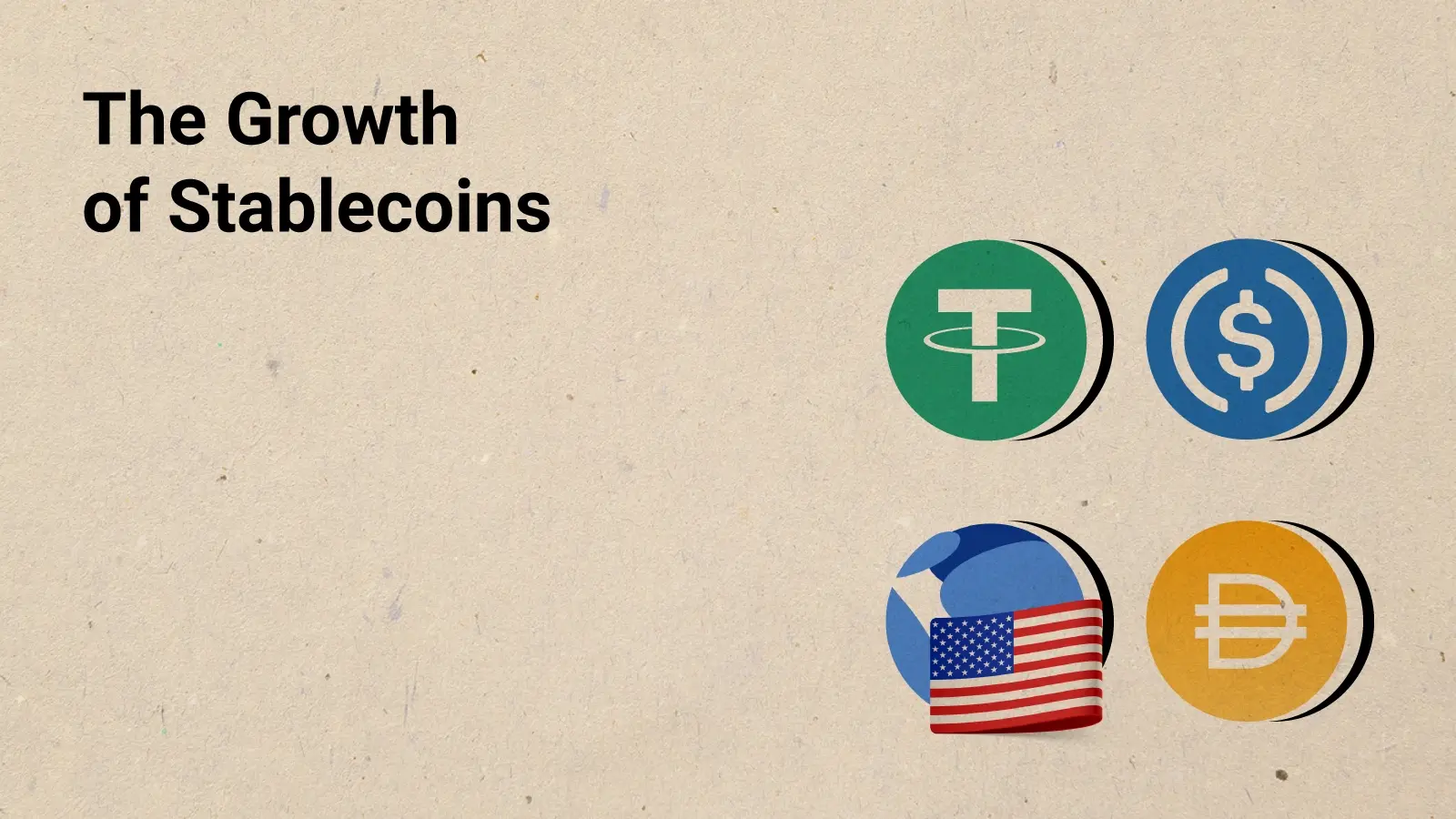
While cryptocurrencies have a viable monetary role as a medium of exchange, they are inherently too volatile to be used as a unit of account or a store of value. The unreliable nature of popular cryptocurrencies like bitcoin is the reason why cryptocurrency still hasn’t made its way to mainstream commerce. Crypto investors can become millionaires overnight and lose all their money weeks later.
This is where stablecoins come into play, allowing investors to enjoy the benefits of a cryptocurrency without the associated high volatility.
Stablecoins are pegged at a 1:1 ratio to other assets, such as the U.S. dollar or gold, designed to have a value that is much more fixed than regular cryptocurrencies. As a result, stablecoin demand is surging, with the total market cap of stablecoins rising from US$0.02 billion in January 2017 to US$181.73 billion as of April 2022.
Read on to learn everything you need to know about stablecoins, the benefits and limitations of investing in various types of stablecoins, and more.
- Stablecoins
- A stablecoin is a cryptocurrency collateralized by the value of an underlying asset, such as a fiat currency, precious metals like gold, or even other cryptocurrencies. Many stablecoins are pegged at a 1:1 ratio with certain fiat currencies, such as the U.S. dollar, which can be traded on exchanges.
What Are Stablecoins?
Stablecoins are designed to offer the benefits of both worlds—the security and privacy of instant payments of cryptocurrencies and the stability of fiat currencies.
A stablecoin is a cryptocurrency collateralized by the value of an underlying asset, such as a fiat currency, precious metals like gold, or even other cryptocurrencies. Many stablecoins are pegged at a 1:1 ratio with certain fiat currencies, such as the U.S. dollar, which can be traded on exchanges.
The underlying collateral of crypto-collateralized stablecoins is another cryptocurrency. Such stablecoins are over-collateralized—i.e., a larger number of cryptocurrencies are kept as a reserve for issuing a lower number of stablecoins due to the high volatility of the reserve cryptocurrency.
How Do Stablecoins Maintain Their Peg?
Stablecoins achieve price stability via collateralization or through algorithmic market modules.
Collateralization
Collateralized stablecoins maintain a fiat currency reserve, like the U.S. dollar, as collateral to issue a suitable number of crypto coins. Other forms of collateral can include cryptocurrency, gold, or commodities like oil.
Such reserves are maintained and regularly audited by independent custodians and companies. Fiat-backed stablecoins are backed at a 1:1 ratio, so real fiat currency is held in a bank account to back up each stablecoin. If a person needs to redeem cash with stablecoins, the entity that manages the stablecoin will take out the amount of fiat from their reserve and send it to the person’s bank account. The equivalent stablecoins are then “burned” or permanently removed from circulation.
For example, a stablecoin like USDC, fully backed by U.S. dollars and dollar-denominated assets at a 1:1 ratio, would maintain its peg by storing a dollar when one USDC is minted. If you initiate a transaction to buy one USD Coin using fiat currency, then that fiat currency is deposited and stored as one U.S. dollar, and the new USDC is minted. If you sell a USD Coin in exchange for fiat currency, then the USDC is “burned” when the fiat money is transferred back to your bank account.
However, most stablecoins pegged to a fiat currency aren’t backed entirely by money. A stablecoin may also be partly backed by secured loans, corporate bonds, precious metals, and other investments. The idea is that their total value is equal to the total number of stablecoin units minted so far. For example, the bulk of Tether’s reserves is in cash, commercial paper, treasury bills, reverse repo notes, and fiduciary deposits.
Other stablecoins, such as Terra (UST) or Dai, are backed by crypto locked in Maker vaults and employ algorithms for stability.
Algorithmic Market Modules
An alternative model is using an algorithm and associated reserve token to peg a stablecoin to USD — instead of using cash reserves. Algorithmic stablecoins do not have any collateral by design – the collateral is its governance token that can be minted or burned to stabilize the price.
For example, the Terra protocol is designed so that users can always swap the LUNA token for UST, and vice versa, at a guaranteed price of $1. If demand for UST rises and its price rises above $1, LUNA holders can swap $1 of LUNA to create one UST token.
During the swapping process, a percentage of LUNA is burned, and the remainder is deposited into a community treasury. Burning a percentage of LUNA tokens reduces the number of overall tokens left in circulation, making them more scarce and, therefore, more valuable. By minting more UST tokens, the overall price is brought back down to its $1 level.
If demand is low for UST and the price falls below $1, UST holders can exchange their UST tokens at a ratio of 1:1 for LUNA.
Other coins like Ampleforth (AMPL) employ a rebasing method when the software programmatically adjusts the supply of its AMPL cryptocurrency every 24 hours. If demand for AMPL tokens is high, and each AMPL token exceeds $1, the supply will increase. If demand is low, supply will decrease.
Other tokens like BASED and RMPL aim to improve this mechanism.
Threats to Stablecoin Pegs
While stablecoins may appear to be low risk, they present some risks. The primary risk of stablecoins is if they aren’t fully backed by the reserve currencies. Risks include:
Reserve Risk
Reserves backing a stablecoin guarantee the value of a stablecoin and are essential for the stablecoin ecosystem.
Counterparty Risk
For the currency to maintain its value, the bank holding the reserves and the organization issuing the stablecoin must be doing the right things (security, properly reserving, etc.).
Security
Like other cryptocurrencies, stablecoins must be held in a secure digital wallet since a trading platform may be prone to hacks.
Protocol Malfunctioning
Protocol malfunctioning is a great threat to stablecoins that rely on algorithmic market modules. If there are flaws or vulnerabilities in the code that handles minting and burning, a stablecoin can lose its peg.
Additionally, a considerable portion of stablecoins is held in liquidity pools, and some Decentralized Finance (DeFi) protocols like Compound have tokens that track underlying assets (cTokens like cDai, cUSDC, etc.). If these DEX pools or the smart contracts governing cTokens are compromised, an attacker can mint large sums of unbacked tokens or steal from a pool and quickly dump them on the open market. As a result, the stablecoin’s supply will outweigh its reserves; the price swings will exacerbate selling pressure and break the peg.
Summary
While stablecoins offer the best of both worlds, they come with risks associated with investing in them. Along with the risks mentioned above, some stablecoins, such as Neutrino (USDN), are losing their pegs and have recently dropped from the US$1.00 target to US$0.76.
There’s also the case of Iron Finance, where a significant delay between the price feed oracle and real-time data rendered arbitraging unprofitable. As a result, the base token, TITAN, lost nearly all its value, and the associated IRON stable coin dropped to US$0.94.
Each stablecoin comes with its unique advantages and drawbacks and uses diverse collateral methods to achieve price stability, so make sure to check the issuer’s reserve reports and the implemented audits before investing in them.






![how-to-buy-mooncoin-(moon)-[the-ultimate-guide-2022]](https://cryptosens.pro/wp-content/uploads/2022/08/3534-how-to-buy-mooncoin-moon-the-ultimate-guide-2022-380x250.webp)
![how-to-buy-maker [step-by-step-guide]](https://cryptosens.pro/wp-content/uploads/2022/11/7517-how-to-buy-maker-step-by-step-guide-380x250.webp)

I truly appreciate your piece of work, Great post.
Good write-up, I’m regular visitor of one’s blog, maintain up the excellent operate, and It is going to be a regular visitor for a lengthy time.